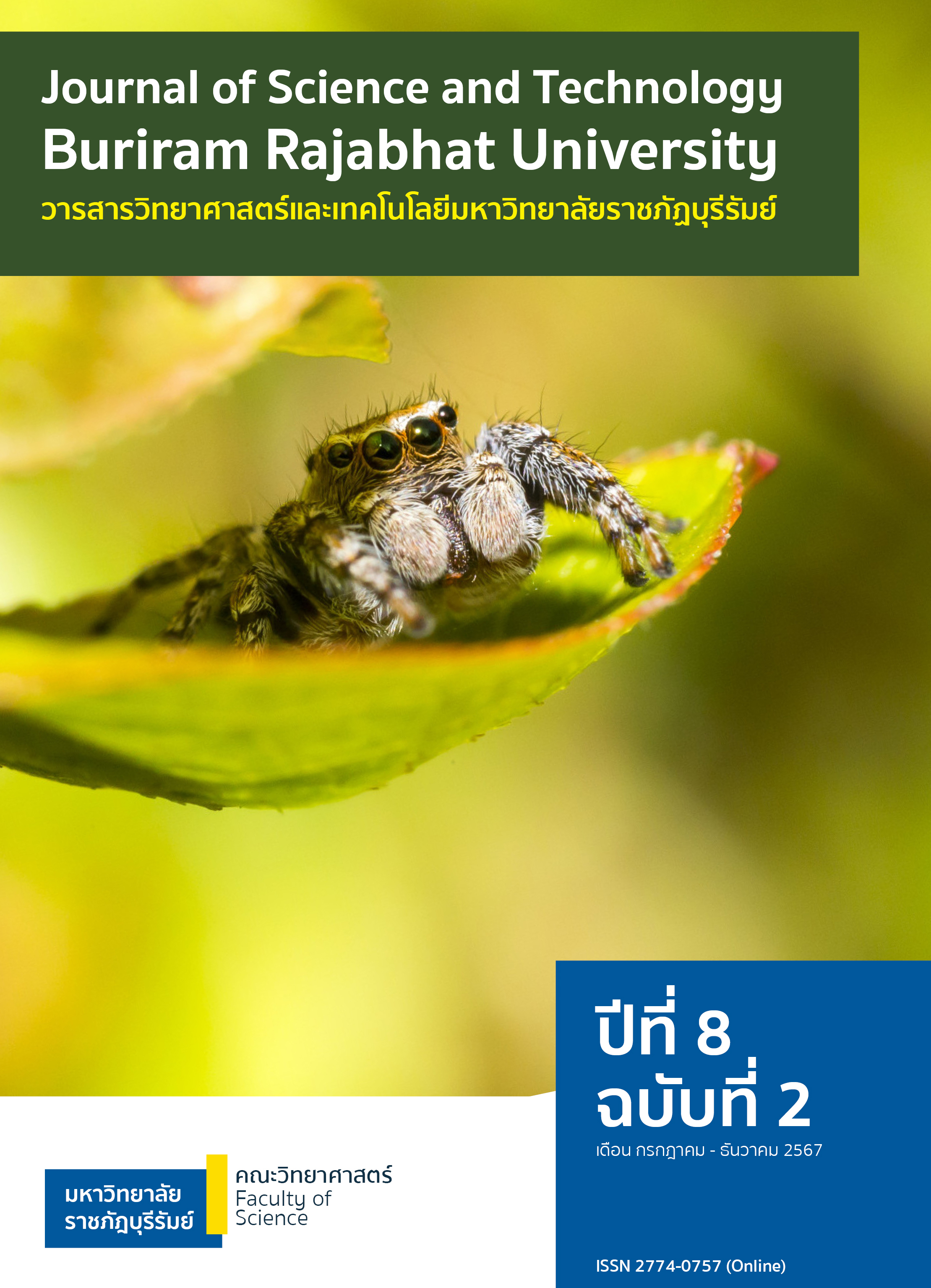การพัฒนาไคโตซาน/คอลลาเจนไฮโดรเจลที่มีความไวต่อการเปลี่ยนแปลงอุณหภูมิ และมีคุณสมบัติต้านแบคทีเรียโดยใช้อนุภาคนาโนเงินชีวสังเคราะห์ จากสารสกัดน้ำกระชายขาวเพื่อการปลูกถ่ายกระดูก
Main Article Content
บทคัดย่อ
ไฮโดรเจลที่มีความไวต่อการเปลี่ยนแปลงอุณหภูมิได้ถูกพัฒนาและนำมาใช้ในงานวิศวกรรมเนื้อเยื่อกระดูกเพื่อส่งเสริมการสร้างกระดูกใหม่และนำส่งสารออกฤทธิ์ งานวิจัยนี้จึงมีเป้าหมายที่จะเตรียมไคโตซาน/คอลลาเจนไฮโดรเจลที่มีคุณสมบัติต้านแบคทีเรียโดยการเติมอนุภาคนาโนเงินสังเคราะห์ทางชีวภาพ สารสกัดน้ำของกระชายขาว (โบเซนเบอร์เกียโรทุนดา) ถูกใช้เป็นตัวรีดิวซ์สำหรับการสังเคราะห์อนุภาคนาโนเงิน ดังนั้น อนุภาคนาโนเงินจึงถูกแสดงคุณลักษณะโดยการทดสอบสเปกโตรโฟโตเมตรี สัณฐานวิทยา และสมบัติทางชีวภาพ อนุภาคนาโนเงินเป็นรูปทรงกลมที่มีเส้นผ่านศูนย์กลางตั้งแต่ 20-40 นาโนเมตร โดยมีฤทธิ์ยับยั้งเชื้อ สแตฟิโลค็อกคัสออเรียสและซูโดโมนาสแอรูจิโนซา อนุภาคนาโนเงินที่สังเคราะห์ขึ้นถูกผสมกับไคโตซาน/คอลลาเจนไฮโดรเจลให้มีความเข้มข้นร้อยละ 1 โดยน้ำหนักต่อปริมาตร และถูกตรวจสอบคุณสมบัติทางรีโอโลยี ทางโครงสร้าง ทางเคมี และทางชีวภาพ ผลที่ได้พิสูจน์ว่าการเติมอนุภาคนาโนเงินส่งผลต่ออุณหภูมิการเกิดเจลและเวลาในการเกิดเจล รวมทั้งมอดุลัสของไฮโดรเจล สัณฐานวิทยาเชิงโครงสร้าง (ขนาด และความพรุน) ของไฮโดรเจลเปลี่ยนแปลงกับการเติมอนุภาคนาโนเงินที่สังเคราะห์ขึ้น นอกจากนี้ไฮโดรเจลที่เติมอนุภาคนาโนเงินยังแสดงประสิทธิภาพการต้านแบคทีเรียที่ดีกว่าไฮโดรเจลปราศจากอนุภาคนาโนเงิน
Article Details

อนุญาตภายใต้เงื่อนไข Creative Commons Attribution-NonCommercial-NoDerivatives 4.0 International License.
เนื้อหาและข้อมูลในบทความที่ลงตีพิมพ์ในวารสารวารสารวิทยาศาสตร์และเทคโนโลยีถือเป็นข้อคิดเห็นและความรับผิดชอบของผู้เขียนบทความโดยตรงซึ่งกองบรรณาธิการวารสาร ไม่จำเป็นต้องเห็นด้วย หรือร่วมรับผิดชอบใด ๆ
บทความ ข้อมูล เนื้อหา รูปภาพ ฯลฯ ที่ได้รับการตีพิมพ์ในวารสารวารสารวิทยาศาสตร์และเทคโนโลยีถือเป็นลิขสิทธิ์ของวารสารวารสารวิทยาศาสตร์และเทคโนโลยีหากบุคคลหรือหน่วยงานใดต้องการนำทั้งหมดหรือส่วนหนึ่งส่วนใดไปเผยแพร่ต่อหรือเพื่อกระทำการใด ๆ จะต้องได้รับอนุญาตเป็นลายลักษณ์อักษรจากวารสารวารสารวิทยาศาสตร์และเทคโนโลยี ก่อนเท่านั้น
เอกสารอ้างอิง
Bruna, T., Maldonado-Bravo, F., Jara, P., & Caro, N. (2021). Silver Nanoparticles and Their Antibacterial Applications. Int J Mol Sci, 22(13). doi:10.3390/ijms22137202
Chen, M., Pan, X., Wu, H., Han, K., Xie, X., Wedge, D., . . . Wu, C. (2011). Preparation and anti-bacterial properties of a temperature-sensitive gel containing silver nanoparticles. Die Pharmazie-An International Journal of Pharmaceutical Sciences, 66(4), 272-277.
Chen, M., Yang, Z., Wu, H., Pan, X., Xie, X., & Wu, C. (2011). Antimicrobial activity and the mechanism of silver nanoparticle thermosensitive gel. Int J Nanomedicine, 6, 2873-2877. doi:10.2147/ijn.S23945
Chenite, A., Chaput, C., Wang, D., Combes, C., Buschmann, M. D., Hoemann, C., . . . Selmani, A. (2000). Novel injectable neutral solutions of chitosan form biodegradable gels in situ. Biomaterials, 21(21), 2155-2161.
Couto, D. S., Hong, Z., & Mano, J. F. (2009). Development of bioactive and biodegradable chitosan-based injectable systems containing bioactive glass nanoparticles. Acta Biomaterialia, 5(1), 115-123.
Dang, Q., Liu, K., Zhang, Z., Liu, C., Liu, X., Xin, Y., . . . Fan, B. (2017). Fabrication and evaluation of thermosensitive chitosan/collagen/α, β-glycerophosphate hydrogels for tissue regeneration. Carbohydr Polym, 167, 145-157. doi:10.1016/j.carbpol.2017.03.053
Ding, K., Yang, Z., Zhang, Y. L., & Xu, J. Z. (2013). Injectable thermosensitive chitosan/β-glycerophosphate/collagen hydrogel maintains the plasticity of skeletal muscle satellite cells and supports their in vivo viability. Cell Biol Int, 37(9), 977-987. doi:10.1002/cbin.10123
Govindaraju, K., Selvaraj, T., Kiruthiga, V., & Singaravelu, G. (2010). Biogenic silver nanoparticles by Solanum torvum and their promising antimicrobial activity. Journal of Biopesticides, 3, 394-399.
Hong, K. H. (2007). Preparation and properties of electrospun poly (vinyl alcohol)/silver fiber web as wound dressings. Polymer Engineering & Science, 47(1), 43-49.
Huang, H., Yuan, Q., & Yang, X. (2004). Preparation and characterization of metal–chitosan nanocomposites. Colloids and surfaces B: Biointerfaces, 39(1-2), 31-37.
Kaur, K., Sa'Paiva, S., Caffrey, D., Cavanagh, B. L., & Murphy, C. M. (2021). Injectable chitosan/collagen hydrogels nano-engineered with functionalized single wall carbon nanotubes for minimally invasive applications in bone. Materials Science and Engineering: C, 128, 112340.
Lavertu, M., Filion, D., & Buschmann, M. D. (2008). Heat-induced transfer of protons from chitosan to glycerol phosphate produces chitosan precipitation and gelation. Biomacromolecules, 9(2), 640-650.
Li, X., Xu, H., Chen, Z.-S., & Chen, G. (2011). Biosynthesis of Nanoparticles by Microorganisms and Their Applications. Journal of Nanomaterials, 2011, 1-16. doi:10.1155/2011/270974
Miguel, S. P., Ribeiro, M. P., Brancal, H., Coutinho, P., & Correia, I. J. (2014). Thermoresponsive chitosan-agarose hydrogel for skin regeneration. Carbohydr Polym, 111, 366-373. doi:10.1016/j.carbpol.2014.04.093
Moreira, C. D., Carvalho, S. M., Mansur, H. S., & Pereira, M. M. (2016). Thermogelling chitosan–collagen–bioactive glass nanoparticle hybrids as potential injectable systems for tissue engineering. Materials Science and Engineering: C, 58, 1207-1216.
Murugadoss, A., & Chattopadhyay, A. (2007). A ‘green’chitosan–silver nanoparticle composite as a heterogeneous as well as micro-heterogeneous catalyst. Nanotechnology, 19(1), 015603.
Ni, P., Ding, Q., Fan, M., Liao, J., Qian, Z., Luo, J., . . . Wei, Y. (2014). Injectable thermosensitive PEG–PCL–PEG hydrogel/acellular bone matrix composite for bone regeneration in cranial defects. Biomaterials, 35(1), 236-248.
Ramteke, C., Chakrabarti, T., Sarangi, B. K., & Pandey, R.-A. (2013). Synthesis of silver nanoparticles from the aqueous extract of leaves of Ocimum sanctum for enhanced antibacterial activity. Journal of chemistry, 2013.
Roy, N., & Barik, A. (2010). Green synthesis of silver nanoparticles from the unexploited weed resources. International Journal of Nanotechnology and applications, 4(2), 95-101.
Sámano-Valencia, C., Martínez-Castañón, G., Martínez-Gutiérrez, F., Ruiz, F., Toro-Vázquez, J., Morales-Rueda, J., . . . Martínez, N. N. (2014). Characterization and biocompatibility of chitosan gels with silver and gold nanoparticles. Journal of Nanomaterials, 2014, 142-142.
Siripanth, J., & Wongwitthayakool, P. (2018). Flexural Strength and Viscoelastic Properties of Acrylic Resin Denture Base Material Containing Silver Nanoparticle Synthesized from Fingerroot Aqueous Extract. Key Engineering Materials, 777, 178-182. doi:10.4028/www.scientific.net/KEM.777.178
Szymaǹska, E., Sosnowska, K., Miltyk, W., Rusak, M., Basa, A., & Winnicka, K. (2015). The Effect of β-Glycerophosphate Crosslinking on Chitosan Cytotoxicity and Properties of Hydrogels for Vaginal Application. Polymers, 7(11), 2223-2244. Retrieved from https://www.mdpi.com/2073-4360/7/11/1510
Wongwitthayakool, P., & Pudla, M. (2018). Thermal Properties of Acrylic Resin Denture Base Material Containing Silver Nanoparticle Synthesized from Aqueous Extract of Boesenbergia rotunda. Key Engineering Materials, 777, 173-177. doi:10.4028/www.scientific.net/KEM.777.173
Xie, Y., Liao, X., Zhang, J., Yang, F., & Fan, Z. (2018). Novel chitosan hydrogels reinforced by silver nanoparticles with ultrahigh mechanical and high antibacterial properties for accelerating wound healing. International Journal of Biological Macromolecules, 119, 402-412.
Yin, I. X., Zhang, J., Zhao, I. S., Mei, M. L., Li, Q., & Chu, C. H. (2020). The Antibacterial Mechanism of Silver Nanoparticles and Its Application in Dentistry. Int J Nanomedicine, 15, 2555-2562. doi:10.2147/ijn.S246764
You, C., Li, Q., Wang, X., Wu, P., Ho, J., Jin, R., . . . Han, C. (2017). Silver nanoparticle loaded collagen/chitosan scaffolds promote wound healing via regulating fibroblast migration and macrophage activation. Scientific reports, 7. doi:10.1038/s41598-017-10481-0


